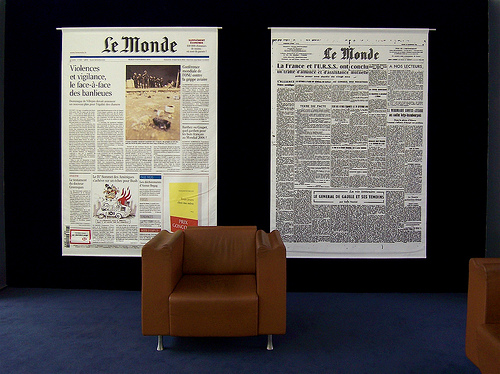One of the most fascinating insights in the Reuters Institute 2013 Digital News Report is the relative performance of today’s news organisations in the online space as opposed to their performance offline.
The figures in the report suggest that in the UK big offline brands like the Guardian, Sky News, the BBC and the Daily Mail do well online, more or less sustaining their offline share or in the case of the Guardian significantly increasing it. Strikingly and maybe a sign of things to come, amongst our respondents, The Huffington Post a new online only brand in the UK came in ahead of The Sun, Britain’s bestselling paper.
In France both Le Monde (which increases an offline share of 6% of our sample to 13% online) and Le Figaro seem to do better online than offline, but French broadcasters find the online environment tougher. Meanwhile in Germany Der Spiegel is the big gainer online whereas broadcasters tend to lose out to publishers and aggregators such as Google News.
News organisations that will succeed in 2020 are those that can emulate the success of some of these brands performing as well, or even better in the more competitive online space, than they have offline. Against that background I’ll offer some guiding principles about the future of news (papers) organised around the following headings; Content, Convenience, Consumers and the Cash.
The findings are all based on the Reuters Digital News Report, which surveyed 11,000 internet users in nine countries including the UK, Germany, Brazil, the US and Japan. This research was conducted by polling company YouGov using an online questionnaire at the end of January/beginning of February 2013. The data was weighted to targets set on age and gender, region, newspaper readership, and social grade to reflect the total population of each country.
First Content. We are all in the content business. However we have a natural tendency to think that our content is more valuable and certainly more important – to society, to people and to democracy –than any other content. Many of us may share that view, but at the same time we need to recognise that we are in an increasingly commoditised and competitive content business, people are time poor, there is far more content than anyone can possibly consume and much of it is free. Given all that it’s hard to stand out from the crowd, unless we focus on content that really adds value and helps build the brand.
Adding value means journalism that moves beyond the old journalistic guiding watchwords of “Who, what, where?” Valued as opposed to commoditised journalism needs to ask “Why, how, and what next?” about all major stories. That’s one of the ways to create stickiness, bringing people back to us.
Alongside that we need investigative pieces and exclusives that are both valuable in terms of our democratic function and help people remember us. UK examples include the Daily Telegraph on politicians expenses (The Guardian’s recent stories on US NSA digital monitoring, Reuters investigations into tax avoidance by companies such as Starbucks, and in France the work done by Mediapart on budget minister Jerome Cahuzac).
And finally we need to really own niches around specific expertise that people identify with our news organisation. That’s a point that I’ll revert to when we come to the cash.
Second Convenience – News is multiplatform now and users want different experiences depending on how and where they access.
News organisations must be everywhere, wherever their users might want to use them. PC, mobile, tablets, and print. That’s expensive but essential as behaviour changes fast. If you’re not there others will pick up your readers. (In Japan the Reuters Institute Digital News report shows that in spite of the historic strength of Japanese newspapers none of the top three online news brands there are traditional news companies) And there are benefits. We know that in the UK the more devices people own the more likely they are to access online newspaper brands ranging from 33% with one device, to 63% for people with three devices. If you’re across all main devices you both avoid losing out and can appeal at different times of day to the real news lovers.
But news being multiplatform also means that content must work well on each platform and that recognizes that user needs will vary. Le Monde and the Financial Times have pioneered in offering readers the option on the tablet both to see today’s paper and a constantly updated news feed. Le Monde has gone further offering different ways of interacting with today’s paper on the tablet where you can choose something that is close to a PDF of the paper or the opportunity to flick and fold the pages and get a sense of the overview as you do with the real paper. These changes reflect the differences between users – and the fact that even the same reader may want different experiences at different times on different platforms. Sometimes quick updates, sometimes in depth articles, sometimes something that is a closer reflection of the range – but also the finiteness – of the physical newspaper.
Thirdly Consumers – News organisations that want to be in business and thriving in 2020 need to know their readers and engage with them better than ever. That breaks down into data, engagement, responsiveness.
Clever news organisations gather the mass of data generated by their customers to understand them better and build a relationship with them. Traditionally UK newspapers didn’t know that much about their customers; even with subscribers the relationship was owned by the newsagent who delivered the paper, not the newspaper organisation itself. Other countries did better at developing relationships with their subscribers, in many cases even taking responsibility for direct delivery to the customer. But now everyone can get close to their digital customers, but it depends first on gathering the data and then developing big data strategies to have an intelligent interaction with different customers, both the occasional user and the regular subscriber as well of course with advertisers.
Openness and engagement with your readers is essential – both because increasingly readers expect it and if they’re not engaging with you they will be with someone else – on Facebook or elsewhere – and because when it works well it can really contribute to and amplify your newsgathering efforts.
Responsiveness is about applying the first two principles – to deliver things that are valued by your users. That doesn’t mean that you dilute your editorial integrity and sacrifice your news values to whatever is trending on social media right now. What it does means is being able to offer readers more of what they’re interested in as well as setting out your front page – whether physical or digital –as you think fits with your overall editorial values.
Finally the Cash. Against all this change and the decline of print revenues news organisations need to find intelligent ways to monetise content.
It’s time to move beyond the outdated theology – of paywalls good or bad that has dominated some recent debates in the UK. Apart from the very largest news organisations with global reach for most of us the future will be hybrid – about permeable or metered paywalls – where you don’t freeze out all traffic but where you can charge either for regular use, for added value or convenience eg on the iPad, or for some premium content
Clearly this strategy is easiest for premium niche products – the FT, Economist, Wall Street Journal, New York Times, and much harder for general news especially in smaller countries than the US.
But we should remember that many of us all have niche products that some people will pay for. For example in the UK I’d pay for the Media Guardian, and I expect many others would too, since they’ve built an expert niche there that is a must have if you’re in the industry and where there are relatively few substitutes.
For me an intelligent approach to the cash combines three things. First, focusing on reader needs and being clear about what it’s reasonable to expect them to pay for. Second, avoiding hard paywalls that kill your traffic and references from social media unless you really know that you are a must have product. Finally, finding ways to make payment as frictionless as possible whilst limiting disintermediation. That’s hard, but alongside Apple and iTunes there are other examples of people going it alone. Not just the FT but also consortia such as Piano Media offering competing news brands a way to market a package of news products, to retain more of the margin, and above all to keep the customer data. So, I’m confident there is a way ahead and there are ways to continue to provide quality news and find a way to pay for it.
Those news organisations that survive and thrive in 2020 will not just focus on the 4 things I’ve outlined here – valued content, knowing their customers, offering greater convenience, and thinking about intelligent ways to bring in the cash – to monetise their content. They will also be watching how the digital news consumer’s behaviour is changing, not just at home but in other similar markets, and we hope looking and learning from comparative studies such as ours. Traditionally news organisations tended to emulate the behavior of the peers, within their domestic market. Organisations that want to thrive in 2020 need to raise their sights, looking at innovation across similar markets, wherever they might be, and learn more about how consumers are behaving today at home and abroad, and working out what they’re likely to expect in the future.
This article is based on comments made at a panel discussion at the Global Editors Network News Summit 2013:Our Vision of a Daily News(Paper/Media) in 2020 Thursday 20th June
Participants: Natalie Nougayrède, Editor in Chief, Le Monde, Juan Luis Cebrian, Prisa and El-Pais, David Levy, Reuters Institute, Oxford University and Michael Maness, of the Knight Foundation.
The Reuters Institute is a partner of the European Journalism Observatory
Photo credit: Dulnan / CC Flickr
Tags: New media, News, news orniganazitions, Reuters Institute, Reuters Institute Digital News Report, YouGov











































